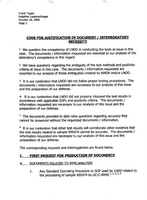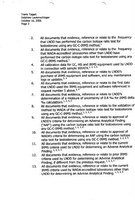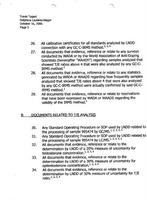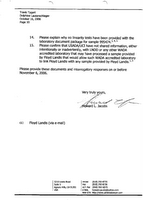Rejected Doc Request (Correspondence Part 2)
This is Part 2 of our series on Correspondence between Landis and the USADA.
In Part 1, we got presented the USADA's conclusion that they wouldn't be giving Landis anything more than the LDP already provided, because they, the USADA, didn't need to. This leaves aside the fact that the rules apparently being cited were for the Laboratory, not the USADA.
The USADA letter made reference to an October 16 request that had been made by the Landis side, which we'll show and discuss in detail below.
This document request provides important clues into the defense. The Landis side could not know at the time it was prepared if it (or any subsequent) request would be entertained, either by the USADA or the arbitrators. If they ask here, they might get it; if they don't, they may never get another chance. Therefore, they would want to include requests for the things they consider critical to supporting the case they are likely to be making. There are probably things that are less important as well, but each request needs to be considered in light of the question,
"how does this relate to one of the cards Landis is holding face down?"
[more]
[continuation]
On October 16, Jacobs sent a 10 page letter to the USADA identifying documents Landis believed were within USADA's command to produce, along with a number of questions they believed should be answered. The pages in that letter are snapshotted as images in the remainder of this post.
Clicking on each page image will take you to enlarged (but not full size) page images, or you can pull up the full letter in pdf. Page 1 says this is a request to USADA and to the UCI for production of documents. It explains that in specific requests, the reasons behind each will be annotated using a code described on the following page.
Page 1 says this is a request to USADA and to the UCI for production of documents. It explains that in specific requests, the reasons behind each will be annotated using a code described on the following page.
Comment: It does not identify a rule under which it has been requested; then again, the refusal didn't cite the rules under which it was rejected either! Page 2 Identifies reasons 1-6 for requests, which will be used to annotate the specific demands.
Page 2 Identifies reasons 1-6 for requests, which will be used to annotate the specific demands.
It then begins the requests with Section I, Documents for IRMS analysis.
Comment: the SOP used could be construed as the one already in the LDP. Page 3 continues the IRMS related requests. How often does LNDD do CIR? How often do other labs do CIR? Calibration data absent in LDP for LNDD; Details about IRMS equipment at LNDD; When did LNDD start doing CIR? What did WADA do to validate LNDD's CIR testing? What criteria does LNDD use to declare a CIR positive? What criteria do other labs use to determine a CIR positive? Various flavors of documents that would make clear LNDD does things different than other labs.
Page 3 continues the IRMS related requests. How often does LNDD do CIR? How often do other labs do CIR? Calibration data absent in LDP for LNDD; Details about IRMS equipment at LNDD; When did LNDD start doing CIR? What did WADA do to validate LNDD's CIR testing? What criteria does LNDD use to declare a CIR positive? What criteria do other labs use to determine a CIR positive? Various flavors of documents that would make clear LNDD does things different than other labs.
Comment: some of these could not be provided by LNDD, and would not fall under the restrictions of the ILS definition of the LDP. The data that is LNDD specific might or might not belong in the LDP; whether it should be in the LNDD provided LDP is probably up to the arbitrators to decide.
The key item here is probably the positivity criteria used by LNDD vs. that used by other laboratories. Differences of interpretation between labs is a potential problem for the ADA side. CAS could eventually take a "loosest lab wins" position, and justify that under the rules, but it would be embarrasing for the ADAs. That didn't help Zach Lund. Page 4 continues IRMS related requests, continuing on things that would show LNDD differing from other labs. Expected values for control samples. Documentation of linearity tests and background subtraction methods in use by LNDD. Certifications and approvals for calibration standards. Manufactureres recommended operating pressure;
Page 4 continues IRMS related requests, continuing on things that would show LNDD differing from other labs. Expected values for control samples. Documentation of linearity tests and background subtraction methods in use by LNDD. Certifications and approvals for calibration standards. Manufactureres recommended operating pressure;
Comment: data that seems relevant, most of which arguably should have been in the LDP.
That Landis is bringing up the pedigree of the control samples is very interesting, as it suggest he thinks there may be something wrong with them that would lead to the incorrect result.
Similarly, the mention of operating pressure suggests Landis thinks there was something that may have been wrong with that in a way that would affect the results. Page 5 continues IRMS. Calibration certificates for standards; Statistics about screening samples > 4 TE ratio and results when later analyzed by IRMS. WADA or WAADS documents expressing reservations about IRMS CIR.
Page 5 continues IRMS. Calibration certificates for standards; Statistics about screening samples > 4 TE ratio and results when later analyzed by IRMS. WADA or WAADS documents expressing reservations about IRMS CIR.
Then we get into things related to TE analysis. SOPs for LNDD; Support for 20% uncertainty quoted by LNDD for T concentration; for 30% uncertainty of E measurement; 30% uncertainty for T/E measurement.
Comment: Some should arguably be in the LDP, and what's in the LDP may be considered adequately documented. Other items would be USADA or WADA provided, and not under the ILS restrictions.
The interesting point may be whether the uncertainties quoted by LNDD are consistent with those in use and reported by other labs. If LNDD is claiming 30% and other labs claim 0.05%, that should raise concerns. Page 6 wants the electronic files of the data of the test results; documentation of the correction factors applied; details of the spectroscopic peaks; raw data for the IRMS; non-corrected results before background subtraction; how corrections were determined; calibration; gas purification; more raw data; more spectral peak information.
Page 6 wants the electronic files of the data of the test results; documentation of the correction factors applied; details of the spectroscopic peaks; raw data for the IRMS; non-corrected results before background subtraction; how corrections were determined; calibration; gas purification; more raw data; more spectral peak information.
Comment: all of this can be seen as relevant. Whether it should have been in the LDP is to be determined.
This repeats some concern in the CIR questions about background subtraction methodology, calibration, procedure about reference gases. The requests for the raw data are also interesting, because many people have had a hard time examining the multi-generation copies of the printouts, which themselves obscure data that may be important. Page 7: accurate time labelling of peaks; explanation why printout is from day after a test; other printouts; chain-of-custody question; corrections not described in LDP; FID traces; Pointed operating pressure question; linearity tests; electronic data for linearity test; explanation and data necessary to duplicate correction calculations; background scans with enough resolution to be useful.
Page 7: accurate time labelling of peaks; explanation why printout is from day after a test; other printouts; chain-of-custody question; corrections not described in LDP; FID traces; Pointed operating pressure question; linearity tests; electronic data for linearity test; explanation and data necessary to duplicate correction calculations; background scans with enough resolution to be useful.
Comment: There's a lot of fishing here, and most of it doesn't seem likely to result in a catch to TBV.
Duckstrap from DPF emails: "FID is Flame Ionization Detector. Basically this ionizes every carbon containing thing in the GC trace, giving a complete chromatogram of everything in there. It should tell you whether there is any interference with the peaks of interest in the IRMS. This is relevant (actually very relevant), since you would like to know that all of the carbon showing up in the IRMS result truly comes from A, E, and Adiol and Ediol and the internal standards."
There is a loaded question about operating pressures, and the interest in the way corrections are done along with the background traces suggest concern about the arithmetic that was done to the raw data. Page 8 finishes with the TE-related questions, and moves into sample handling.
Page 8 finishes with the TE-related questions, and moves into sample handling.
For the TE, we see demands for details about the urine "blank" used against the sample; Data about water blanks; proof that there was no cross-contamination; electronic data of runs against standards; any prepared English translation of early testing documents.
Comment: Some key questions here, whether they have a properly "zeroed" setup, both in terms of the presumed-clean urine and the way they proved and documented the cleanliness of the apparatus before the sample runs.
Sample handling questions follow. Documentation of all results of all tests against Landis' samples over the whole Tour; Documentation of all tests results for Landis from 2001 to present; Documents indicating whether there was sharing of data that would link Landis to samples being tested;
Comment: The first is about establishing a "longitudinal" study, to determine if there were things in the S17 result that are out of line. Out-of-line could mean either "he doped on S17", or that something skewed happened with the handling/processing of the samples for S17. The second is about trying to show historical data to back up any longitudinal. The last seems like a fishing expedition for mud to throw at some point about process violations.
The first seems like a perfectly reasonable request, as it is data that is available from a single source, appears relevant, and shouldn't be onerous to produce. The last few don't seem particularly relevant to the immediate case, and could be very difficult to research and produce. Page 9 begins specific questions Landis would like answered based on examination of the LDP.
Page 9 begins specific questions Landis would like answered based on examination of the LDP.
1. Missing flow rate data.
2. How was calibration gas used
3. Gas purification systems.
4. Time for peaks on MSD TIC scan.
5. Why results are printed a day late?
6. Other corrections that weren't documented?
7. Why was CIR data reported with and without background correction?
8. How can we duplicate the background correction?
9. Did they do a "craig" correction?
10. Were all samples run at 5.3e-6 mb? What was manufacturer's recommendation?
11. Is "Mix cal IRMS 003" the "VG mix"?
12. What was the trap current?
13 What is the lump between 200-800 seconds in one trace?
Comment: I'm not sure why some of these aren't document demands, and some seem redundant with the previous demands. Most of these again seem to related to whether the equipment was properly "zeroed", calibrated, clean from contamination, and operated properly. All of these things could affect the accuracy of results. Page 10:
Page 10:
14. Why were no linearity tests provided?
15. Confirm that the sample anonymity.
Please provide documents and answers to questions by Nov 6.
Comment: Well, they answered by Nov 6.
The absence of linearity data may be important, though I recall seeing some charts in the LDP that appeared to reflect linearity -- though maybe they plotted two points and assumed linearity between them.
Comments
Some of this is probably fishing, and would reasonably be rejected.
Quite a bit of this is data that the USADA would need to provide, reflecting information that doesn't come exclusively from the LNDD. It is not clear what grounds USADA would have for either granting or rejecting the request, because the ILS would not apply, I don't believe.
Technical Technicalities
The most interesting parts are the technical details requested that we had not seen before. These include:
A plausible theory might be that with blank urine that wasn't blank, and absence of purification with either water blank or purifying gas, the sample processing may have been contaminated by the "blank".
Similarly, operating the machines with incorrect pressures and trap currents may result in incorrect results.
There may be other aspects of the defense that did not require additional documentation, and so were not present in the request. An example might be the use of a cortisol metabolite as a reference compound.
An interesting dilemma for USADA is that, absent some of the data requested to prove otherwise, Landis may be able to make a strong case for the theories above, based on the inadequacies of the LDP as provided. Therefore, USADA may be shooting itself in the foot by not providing data that bolsters its own case - assuming the data would bolster the case. If it isn't presented, Landis is free to argue it would be in his favor.
The series continues in Part 3.
Back to Part 1.
All documents presented in this series can be found in the collection at archive.org.
0 comments:
Post a Comment